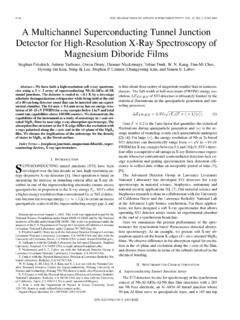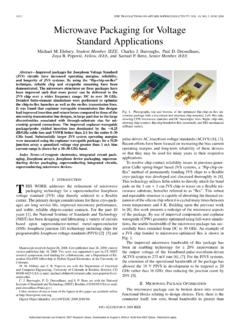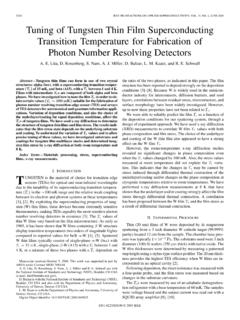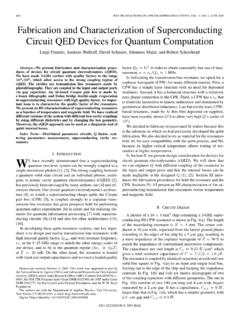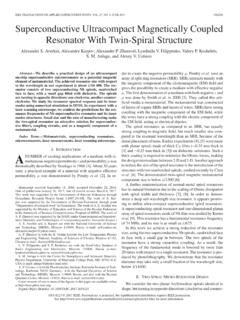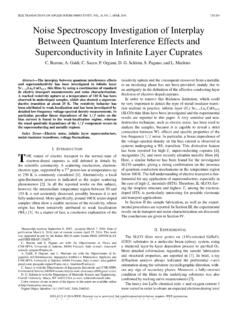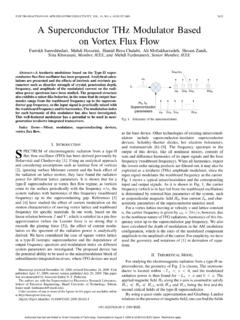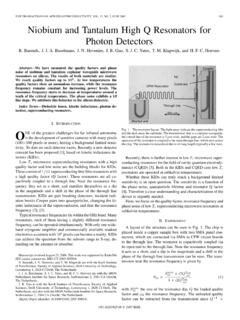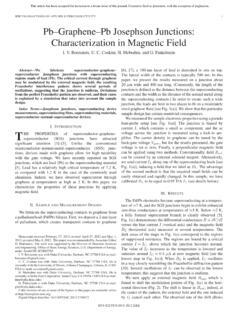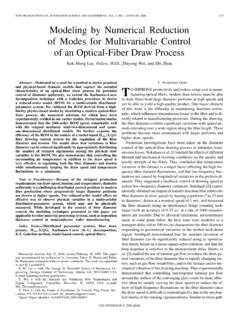Transcription of Test of the ITER central solenoid model coil and CS insert ...
1 600 ieee transactions ON applied SUPERCONDUCTIVITY, VOL. 12, NO. 1, MARCH 2002 Test of the ITER central solenoid model Coiland CS InsertN. Martovetsky, P. Michael, J. Minervini, A. Radovinsky, M. Takayasu, C. Y. Gung, R. Thome, T. Ando, T. Isono,K. Hamada, T. Kato, K. Kawano, N. Koizumi, K. Matsui, H. Nakajima, G. Nishijima, Y. Nunoya, M. Sugimoto,Y. Takahashi, H. Tsuji, D. Bessette, K. Okuno, N. Mitchell, M. Ricci, R. Zanino, L. Savoldi, K. Arai, and A. NinomiyaAbstract The central solenoid model Coil (CSMC) was de-signed and built from 1993 to 1999 by an ITER collaboration be-tween the and Japan, with contributions from the EuropeanUnion and the Russian Federation. The main goal of the projectwas to establish the superconducting magnet technology necessaryfor a large-scale fusion experimental reactor. Three heavily instru-mented insert coils were built to cover a wide operational space fortesting. The CS insert , built by Japan, was tested in April Augustof 2000. The TF insert , built by Russian Federation, will be testedin the fall of 2001.
2 The NbAl insert , built by Japan, will be tested in2002. The testing takes place in the CSMC Test Facility at the JapanAtomic Energy Research Institute, Naka, Japan. The CSMC wascharged successfully without training to its design current of 46 kAto produce 13 T in the magnet bore. The stored energy at 46 kA was640 MJ. This paper presents the main results of the CSMC and theCS insert testing magnet critical parameters, ac losses, joint per-formance, quench characteristics and some results of the Terms Cable in conduit conductors, losses, stability, su-perconducting magnets, INTRODUCTIONTHE 180 t test assembly is shown in Fig. 1. The CSMC con-sists of an Inner Module, Outer Module, insert coil, andsupport structure. This is the largest cable-in-conduit conductor(CICC) magnet ever built. It is also the world s largest pulsedmagnet that has demonstrated stable operation with ramp ratesup to 2 T/s. The conductor for the CSMC and the CS insert useda heavy wall conduit made of Incoloy 908.
3 This alloy, devel-oped for the Nb3Sn CICC applications, has excellent mechan-Manuscript received September 25, 2001. This work was supported by Department of Energy and Government of Martovetsky is with Lawrence Livermore National Laboratory, Livermore,CA 94550 Michael, J. Minervini, A. Radovinsky, M. Takayasu, and C. Y. Gung arewith the Plasma Science and Fusion Center, Massachusetts Institute of Tech-nology, Cambridge, MA 02139 Thome is with General Atomics, San Diego, CA Ando, T. Isono, K. Hamada, T. Kato, K. Kawano, N. Koizumi, K. Matsui,H. Nakajima, G. Nishijima, Y. Nunoya, M. Sugimoto, Y. Takahashi, and are with Japan Atomic Energy Research Institute, Naka-gun, Ibaraki-ken,311-01, Bessette, K. Okuno, and N. Mitchell are with ITER Joint central Team,Naka-gun, Ibaraki-ken, 311-0193 Ricci is with ENEA Frascati, 00044 Zanino and L. Savoldi are with Politecnico, Torino, 10129 Arai is with the National Institute of Advanced Industrial Science andTechnology, 1-1-1 Umezono, Tsukuba-shi, Ibaraki-ken, 305-8568, Ninomiya is with Seikei University, 3-3-1 Kitamachi, Kichijyoji,Musashino-shi, Tokyo, 180-8633, Item Identifier S 1051-8223(02) 1.
4 CSMC and CS insert test properties and also has a compatible coefficient of thermalexpansion, which helps to more fully utilize the properties ofthe strain sensitive test campaign with the CS insert explored a wide param-eter space, with more than 350 runs [1], [2]. The coil and struc-ture instrumentation consisted of more than 500 experiments provided large amount of valuable infor-mation on magnet and conductor performance for conditionsdesigned to simulate a fusion magnet environment, as well asmuch more severe test results were presented in [1], [2]. In this paper weplace more emphasis on interpretation of the tests results in thelight of the post-test analyses. We include unexpected findingsand information to be taken into account for the design of futurefusion MECHANICALPERFORMANCEThe CSMC, CS insert and support structure were heavily in-strumented with strain gauges and displacement sensors to mon-itor strains and displacements throughout the test program.
5 Amajor objective for these measurements was to compare the ob-served coil performance with pretest predictions. As is often the1051-8223/02$ 2002 IEEEMARTOVETSKYet al.: TEST OF THE ITER central solenoid model COIL AND CS INSERT601 Fig. 2. Current sharing temperature and critical current measurements forconductor 1 A in with large cryogenic objects, these mechanical measure-ments presented a large technological CSMC was mechanically preloaded at room temperatureto simulate the load conditions for the central solenoid . Thepreload structure was designed to gain an additional preloadduring cooldown. However, cooldown of the coil did not en-hance the preload to the desired extent; this suggests that thedifference between the CTE of the stainless steel structure andthe winding pack was smaller than predicted by ANSYS modelsof the coil. During electromagnetic operation, the preload de-creased by the full amount indicated by the measured electromagnetic displacements of the CSMCand CS insert did not correspond well with those predicted bypretest analyses.
6 During the tests, several of the radial displace-ment sensors developed a significant zero offset in the presenceof magnetic field, thus their readings are considered axial displacement sensor structure was also magnetizedwhich may or may not contribute to the fact that the measuredaxial displacements were roughly twice their anticipated of the coils electromagnetic strains was not aneasy task either. Discontinuous changes observed in the hoopstrain measurements at the inner radius of the inner modulesuggest that the coupling between the strain gauges and thewinding pack was very poor following initial operation of thecoil. Although the measured results for most other strain gaugemounting locations roughly paralleled the predicted values,there was sufficient variation between sensors measuringthe same nominal behavior to claim a good match betweenmeasurement and acoustic emission (AE) sensors were used on theCSMC. The analysis of the AE diagnostics showed that the AEdecreased significantly after several charging cycles.
7 Duringinitial charging cycles the AE signals correlated with voltagespikes measured on the conductors, which suggested that theAE signals came from the cable moving inside the conduitunder the electromagnetic load. The AE system alloweddetermining the location of the most intensive signals, whichappeared to have been at the ID of the CSMC, at an axiallocation approximately half way between the mid plane andthe coil the difficulties in structural measurements, theCSMC verified in general the validity of the design criteria andFig. characteristic of the CS insert before cyclic testsat 40 kA in 13 T a valuable data for improvements in modeling of thefuture fusion magnets. No plastic behavior was noticed in theCSMC DC PERFORMANCE OFCSMCANDCS INSERTBEFORECYCLINGTESTSC urrent sharing temperature () and critical current mea-surements were carried out on the conductors 1 A, 11 A and theCS insert . Conductors were wound two-in-hand, hence eachlayer has A and B sharing temperatureand critical currentmeasurements under DC conditions showed that the super-conducting properties of the conductor 1 A satisfy the ITER design guidance, which were based on.
8 Summers correlation[3]. Fig. 2 shows DC results measured on the conductor 1A. As seen from Fig. 2, the current sharing measurementat constant current is consistent with the critical currentmeasurement at a fixed temperature, which suggests that theconductor reached its ultimate performance limit. The fittingparameters, describing the properties of the conductor 1 A are:A/mm@ , 12 T,%,0m18 K,20 m28 T, at 10V/m. These fitting parametersshow that the CSMC conductor exceeds the specified strandcurrent density at 12 T and K of 550 A/mm. The cableexperienced a very low strain in the conductor resulting inhighbecause of Incoloy 908 conduit and a proper post-test analysis showed that the results of theexperiment are in a good agreement with more accurate strandcharacterization by the University of Twente group [4], whichindicates no noticeable degradation of the conductor propertieswithin available 11 A also showed slightly better performance inDC operation than expected, although its short and not well-de-fined voltage-generating zone inevitably increased the error barof the test CS insert was heavily instrumented and thus had muchbetter accuracy of measurements than the CSMC measurement revealed the following features.
9 First, themeasured CS insert properties exceeded the ITER design speci-fications, but the strand properties also were significantly higherthan specified and higher than the conductor 1 A , the-factor of the conductor was significantly lowerthan the-factor of the strands. Fig. 3 shows the measuredvoltage-temperature characteristic (VTC) of the CS Insertmeasured on June 6, before cyclic tests. The plot is represented602 ieee transactions ON applied SUPERCONDUCTIVITY, VOL. 12, NO. 1, MARCH 2002 Fig. of theTcsin the CS insert during the test a semi-logarithmic coordinates. Two lines show the expectedperformance of the conductor based on the strand line with the lowercorresponds to strands reacted withthe heat treatment recommended by the strand vendor; theyshowed 120 A critical current at 10V/m in 12 T field at strain [4]. The line with highercharacteristiccorresponds to strand witness samples that were heat treatedwith the CS insert ; their critical current in 12 T field was 162 average(12 T) measured during strand fabrication was142 A.
10 The calculated VTC assumed that the conductor wascompressed strain after the cooldown and stretchedby due to electromagnetic forces, giving a net strain The calculations also assumed a background fieldof 13 T. As seen from the plot, the critical properties at lowelectrical fields seem degraded, especially in comparison withthe witness sample. The-factor in the conductor, used todescribe the transition in the form, is significantlylower than the-factor in the strand [4]. As it is shown inFig. 3, the-factor in the cable is less than half of that forthe strand. Such a behavior resembles the reduction of the-factor in SC coils like T-15 [5] and the WestinghouseLCT coil [6]. These react-and-wound conductors showed bothsignificant broadening of the transition (-factor decrease) anda significant degradation of the superconducting properties. Inthe case of the CS insert , the apparent degradation is not solarge, especially at higher levels of electrical phenomenon has attracted a lot of analytical and exper-imental effort to explain the mechanism of the-factor de-crease and the apparent degradation of superconducting prop-erties.

